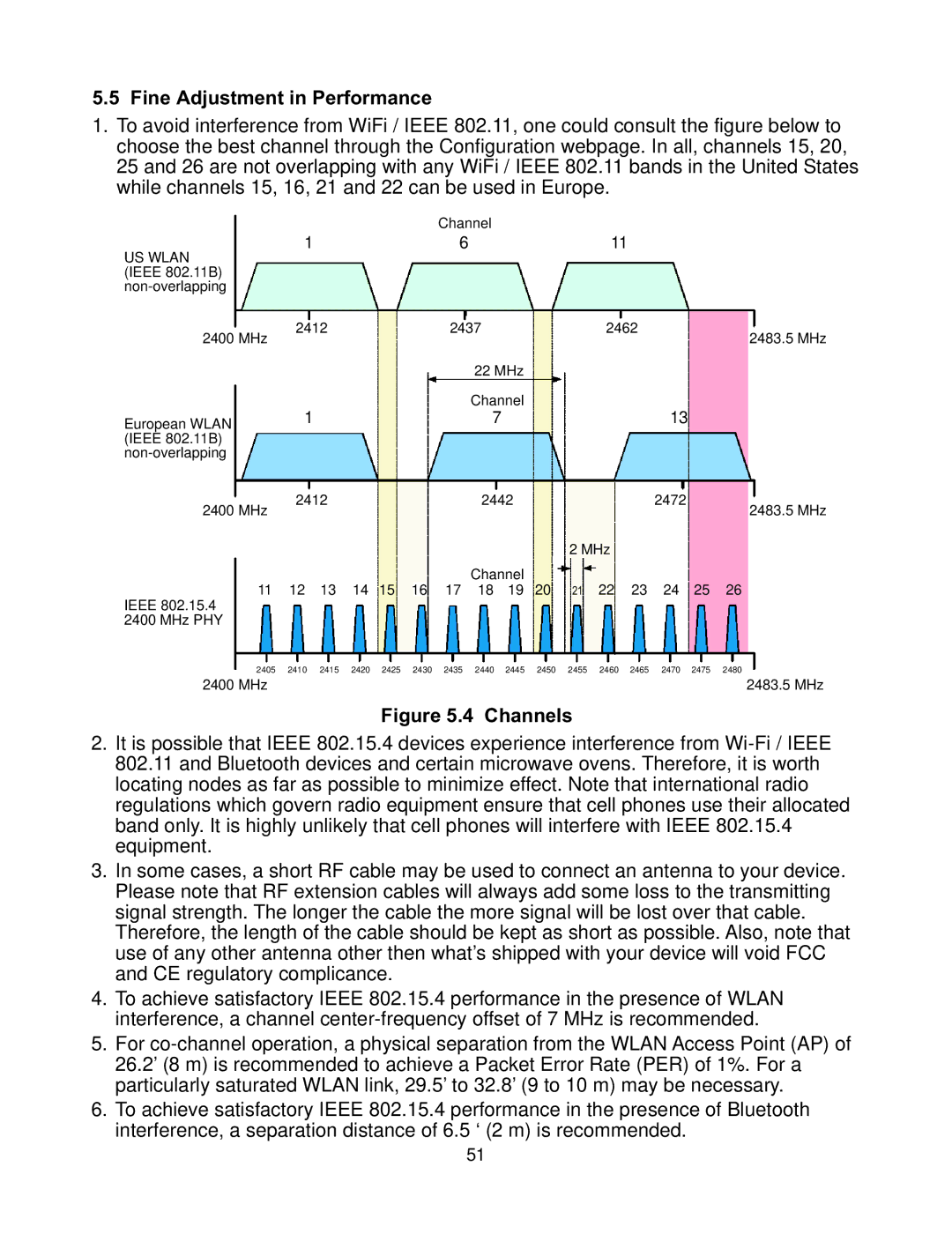
5.5 Fine Adjustment in Performance |
|
|
|
|
|
|
|
|
|
|
| ||||||
1. To avoid interference from WiFi / IEEE 802.11, one could consult the figure below to | |||||||||||||||||
choose the best channel through the Configuration webpage. In all, channels 15, 20, | |||||||||||||||||
25 and 26 are not overlapping with any WiFi / IEEE 802.11 bands in the United States | |||||||||||||||||
while channels 15, 16, 21 and 22 can be used in Europe. |
|
|
|
|
| ||||||||||||
|
| 1 |
|
|
|
| Channel |
|
|
| 11 |
|
|
|
|
| |
US WLAN |
|
|
|
|
| 6 |
|
|
|
|
|
|
|
|
| ||
(IEEE 802.11B) |
|
|
|
|
|
|
|
|
|
|
|
|
|
|
|
|
|
|
|
|
|
|
|
|
|
|
|
|
|
|
|
|
|
| |
2400 MHz | 2412 |
|
|
| 2437 |
|
|
| 2462 |
|
|
| 2483.5 MHz | ||||
|
|
|
|
|
| 22 MHz |
|
|
|
|
|
|
| ||||
|
|
|
|
|
|
|
|
|
|
|
|
|
|
|
| ||
European WLAN |
| 1 |
|
|
|
|
| Channel |
|
|
|
| 13 |
|
|
| |
|
|
|
|
|
| 7 |
|
|
|
|
|
|
|
| |||
(IEEE 802.11B) |
|
|
|
|
|
|
|
|
|
|
|
|
|
|
|
|
|
|
|
|
|
|
|
|
|
|
|
|
|
|
|
|
|
| |
2400 MHz | 2412 |
|
|
|
| 2442 |
|
|
|
| 2472 |
|
| 2483.5 MHz | |||
|
|
|
|
|
|
|
|
|
|
|
|
|
|
| |||
|
|
|
|
|
|
|
| Channel |
| 2 MHz |
|
|
|
|
| ||
|
|
|
|
|
|
|
|
|
|
|
|
|
|
|
| ||
IEEE 802.15.4 | 11 | 12 | 13 | 14 | 15 | 16 | 17 | 18 | 19 | 20 | 21 | 22 | 23 | 24 | 25 | 26 |
|
2400 MHz PHY |
|
|
|
|
|
|
|
|
|
|
|
|
|
|
|
|
|
| 2405 | 2410 | 2415 | 2420 | 2425 | 2430 | 2435 | 2440 | 2445 | 2450 | 2455 | 2460 | 2465 | 2470 | 2475 | 2480 | 2483.5 MHz |
2400 MHz |
|
|
| Figure 5.4 Channels |
|
|
|
|
| ||||||||
2. It is possible that IEEE 802.15.4 devices experience interference from
3. In some cases, a short RF cable may be used to connect an antenna to your device. Please note that RF extension cables will always add some loss to the transmitting signal strength. The longer the cable the more signal will be lost over that cable. Therefore, the length of the cable should be kept as short as possible. Also, note that use of any other antenna other then what’s shipped with your device will void FCC and CE regulatory complicance.
4. To achieve satisfactory IEEE 802.15.4 performance in the presence of WLAN
interference, a channel
5. For
6. To achieve satisfactory IEEE 802.15.4 performance in the presence of Bluetooth interference, a separation distance of 6.5 ‘ (2 m) is recommended.
51
